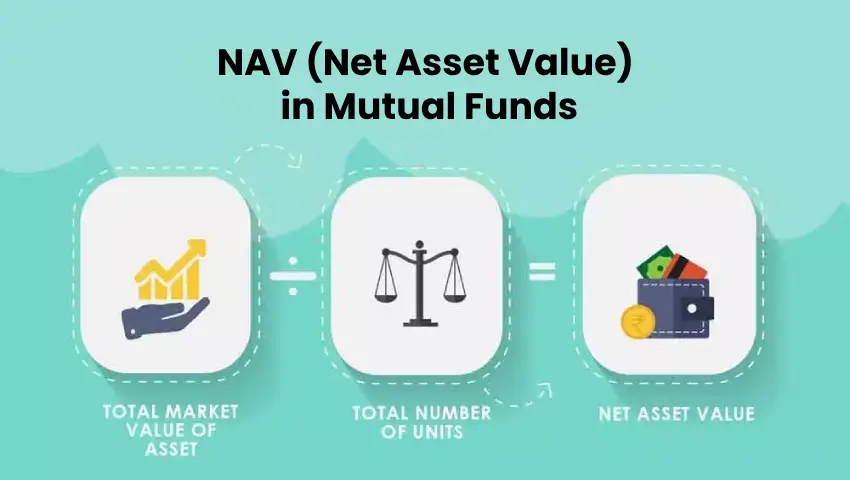
- 28/05/2025
- MyFinanceGyan
- 693 Views
- 3 Likes
- Mutual Fund, Finance
NAV (Net Asset Value) in Mutual Funds: Meaning, Formula & How It Is Calculated?
When choosing a mutual fund, many investors focus on past returns while overlooking one important factor — NAV, or Net Asset Value. It’s a term you’ll frequently come across in the mutual fund world. But what does it actually mean? Is a lower NAV better? Should NAV influence your investment decision?
Let’s break it down in simple terms.
What is NAV (Net Asset Value)?
NAV (Net Asset Value) represents the per-unit value of a mutual fund. In simple words, it’s the price at which you can buy or sell a unit of a mutual fund on a given day.
To calculate NAV, the fund house adds up the total market value of all the securities it holds (stocks, bonds, cash, etc.), subtracts any liabilities and expenses, and divides it by the number of units in circulation.
Think of it like this — NAV is like the daily “scorecard” of a mutual fund, telling you how much each unit is worth.
Formula to Calculate NAV:
Mathematica
Copyedit
NAV = (Total Assets – Total Liabilities) / Total Number of Outstanding Units
Example:
If a mutual fund has:
- Total assets: ₹5,000 crore
- Liabilities: ₹50 crore
- Units Outstanding: 100 crore
Then the NAV = (5000 – 50) / 100 = ₹49.50 per unit
How NAV Works in Practice?
Suppose you invest ₹5,000 in a fund with an NAV of ₹500.
You would receive: ₹5,000 ÷ ₹500 = 10 units
Or say you invest ₹1,00,000 in:
- Fund A (NAV = ₹10): You get 10,000 units
- Fund B (NAV = ₹20): You get 5,000 units
Important: Higher or lower NAV has nothing to do with how cheap or expensive the fund is. What matters is how the fund performs after you invest.
How Often is NAV Calculated?
NAV is calculated once every business day, typically after the market closes. The fund house (AMC) updates the NAV by considering the closing prices of the fund’s portfolio and subtracting the day’s liabilities.
This differs from stocks, whose prices fluctuate throughout the day based on market demand and supply.
How Does Investment Timing Affect NAV?
Thanks to SEBI rules (in place since 2021), your transaction timing decides which day’s NAV you get:
- Buy Orders: If your investment amount reaches the AMC before 3 PM, you get that day’s NAV. Post-3 PM, the next day’s NAV applies.
- Redemption Requests: Submit before 3 PM to get the same day’s NAV; after that, it’s next day’s NAV.
- Liquid/Overnight Funds: The cut-off time is stricter — 1:30 PM for purchases and 3 PM for redemptions.
Example:
If you invest ₹75,000 on March 18, 2025, and the amount is credited before 3 PM, you’ll get the NAV of March 18. If credited at 3:01 PM, the March 19 NAV will apply.
Is NAV the Same as Market Price?
Not quite.
- NAV is the per-unit value of the fund, calculated once a day.
- Stock prices are market-driven and change constantly during trading hours.
NAV gives a stable, once-a-day valuation. Unlike stocks, you can’t “bargain hunt” mutual funds based on NAV.
Why NAV Shouldn't Be the Only Factor in Your Investment?
A common mistake investors make is chasing mutual funds with lower NAVs, assuming they are cheaper or offer more growth potential. This is misleading.
A fund with an NAV of ₹200 may have delivered excellent long-term returns, while another with an NAV of ₹20 might be stagnant.
Key Factors to Consider Instead:
- Fund’s historical performance
- Fund manager’s track record
- Expense ratio
- Your financial goals and risk tolerance
- Investment horizon
Remember: NAV is a snapshot of the fund’s current value, not a guarantee of future performance.
Why NAV Still Matters?
Despite its limitations, NAV is still useful:
- It tells you the price you pay to buy or sell fund units.
- It helps you track how your investment grows over time.
- It ensures transparency and standardization across funds.
But never let NAV alone drive your decision. Focus on the bigger picture.
Conclusion:
NAV (Net Asset Value) is an essential metric in the mutual fund world — it shows you the per-unit value of your investment. However, it should not be mistaken for a predictor of a fund’s success.
Instead of obsessing over a fund’s NAV, take a deeper look at its performance, consistency, cost structure, and how well it fits your investment goals. That’s how smart investors build wealth — not by chasing low NAVs but by making informed choices.
Disclaimer:
The views in this blog are personal and meant for educational purposes only. This is not investment advice or a recommendation to invest in any mutual fund.



